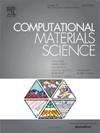Concavity-based local erosion and sphere-size-based local dilation applied to lithium-ion battery electrode microstructures for particle identification
IF 3.1
3区 材料科学
Q2 MATERIALS SCIENCE, MULTIDISCIPLINARY
引用次数: 0
Abstract
Performance metrics of lithium-ion batteries can be extracted from the analysis of electrode microstructures nanoscale imaging. The characterization workflow can involve a challenging particle identification, or instance segmentation, step. In this work, we propose a new identification method based on an original transformation: a sphere-size-based local dilation followed by a concavity-based local erosion, that is local morphology closing. The new transformation is much more efficient than the global morphology closing, with correct identification achieved with only 1.7 % dilation volume and 2.6 % erosion volume on a test geometry, compared to 39.2 % and more than 50 %, respectively, with its global counterpart. The new method has been then benchmarked versus other identification algorithms (watershed and pseudo coulomb repulsive field) on a real electrode microstructure with equal or better segmentation achieved.
基于凹度的局部侵蚀和基于球尺寸的局部膨胀在锂离子电池电极微观结构中的应用
锂离子电池的性能指标可以从电极微结构的纳米级成像分析中提取。表征工作流程可能涉及具有挑战性的粒子识别或实例分割步骤。在这项工作中,我们提出了一种基于原始转换的新的识别方法:基于球体大小的局部膨胀,然后是基于凹度的局部侵蚀,即局部形态闭合。新的转换比整体形态关闭效率高得多,在测试几何形状上仅实现1.7%的膨胀体积和2.6%的侵蚀体积的正确识别,而全球同类方法分别为39.2%和50%以上。然后将新方法与其他识别算法(分水岭和伪库仑排斥场)在真实电极微观结构上进行基准测试,实现了相同或更好的分割。
本文章由计算机程序翻译,如有差异,请以英文原文为准。
求助全文
约1分钟内获得全文
求助全文
来源期刊

Computational Materials Science
工程技术-材料科学:综合
CiteScore
6.50
自引率
6.10%
发文量
665
审稿时长
26 days
期刊介绍:
The goal of Computational Materials Science is to report on results that provide new or unique insights into, or significantly expand our understanding of, the properties of materials or phenomena associated with their design, synthesis, processing, characterization, and utilization. To be relevant to the journal, the results should be applied or applicable to specific material systems that are discussed within the submission.
 求助内容:
求助内容: 应助结果提醒方式:
应助结果提醒方式:


